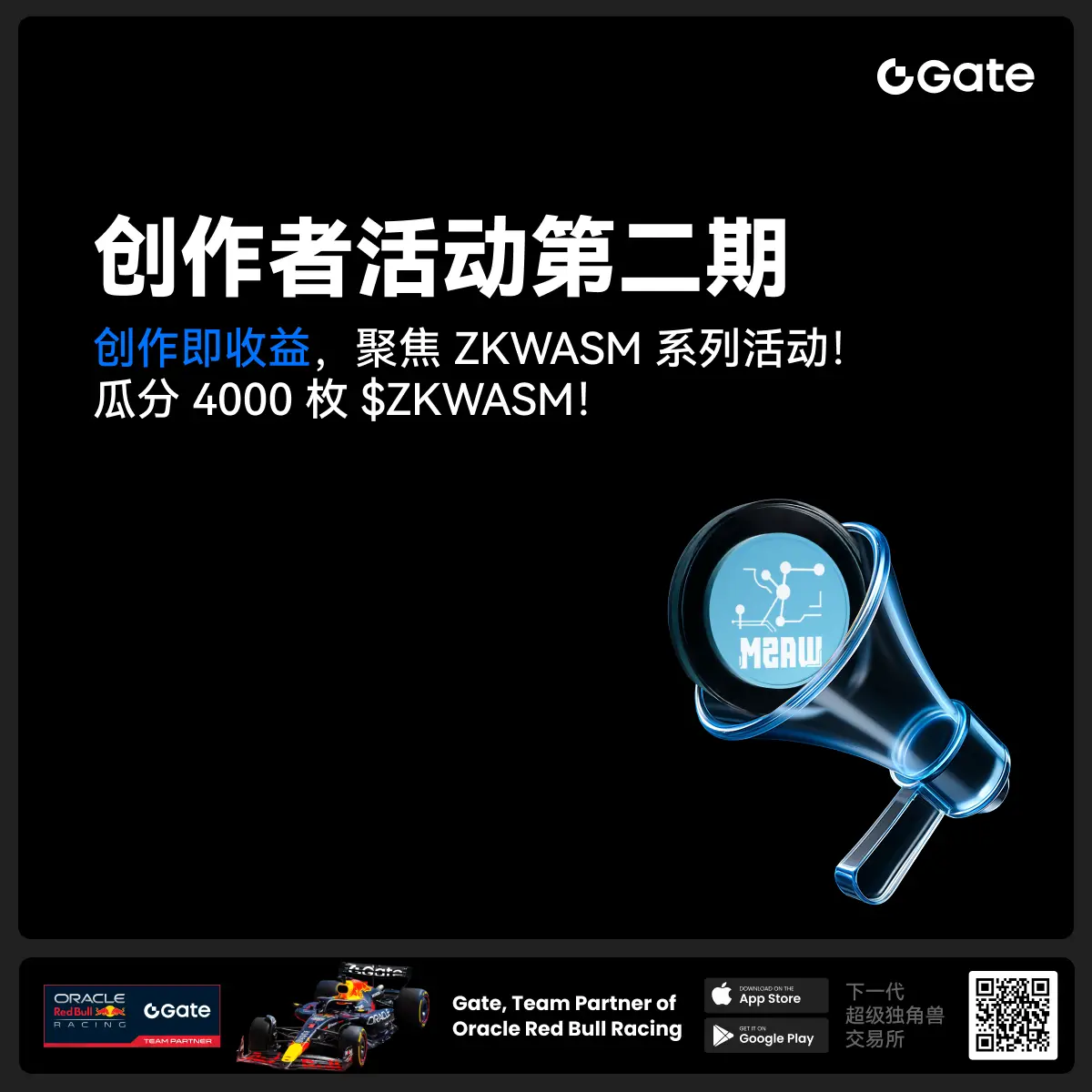- 话题1/3
10k 热度
12k 热度
17k 热度
5k 热度
21k 热度
- 置顶
- 📢 Gate广场 #NERO发帖挑战# 秀观点赢大奖活动火热开启!
Gate NERO生态周来袭!发帖秀出NERO项目洞察和活动实用攻略,瓜分30,000NERO!
💰️ 15位优质发帖用户 * 2,000枚NERO每人
如何参与:
1️⃣ 调研NERO项目
对NERO的基本面、社区治理、发展目标、代币经济模型等方面进行研究,分享你对项目的深度研究。
2️⃣ 参与并分享真实体验
参与NERO生态周相关活动,并晒出你的参与截图、收益图或实用教程。可以是收益展示、简明易懂的新手攻略、小窍门,也可以是行情点位分析,内容详实优先。
3️⃣ 鼓励带新互动
如果你的帖子吸引到他人参与活动,或者有好友评论“已参与/已交易”,将大幅提升你的获奖概率!
NERO热门活动(帖文需附以下活动链接):
NERO Chain (NERO) 生态周:Gate 已上线 NERO 现货交易,为回馈平台用户,HODLer Airdrop、Launchpool、CandyDrop、余币宝已上线 NERO,邀您体验。参与攻略见公告:https://www.gate.com/announcements/article/46284
高质量帖子Tips:
教程越详细、图片越直观、互动量越高,获奖几率越大!
市场见解独到、真实参与经历、有带新互动者,评选将优先考虑。
帖子需原创,字数不少于250字,且需获得至少3条有效互动
- 🎉 亲爱的广场小伙伴们,福利不停,精彩不断!目前广场上这些热门发帖赢奖活动火热进行中,发帖越多,奖励越多,快来GET你的专属好礼吧!🚀
1️⃣ #GateLaunchpad上线IKA# |IKA认购体验
在Gate广场带话题晒出你的IKA Launchpad认购体验,4位幸运分享者讲瓜分$200分享奖池!
详情 👉️ https://www.gate.com/post/status/12566958
2️⃣ #ETH冲击4800# |行情分析预测
大胆发帖预测ETH走势,展示你的市场洞察力!10位幸运用户将平分0.1 ETH 奖励!
详情 👉️ https://www.gate.com/post/status/12322403
3️⃣ #创作者活动第二期# |ZKWASM话题
在广场或推特发布与 ZKWASM 或其交易活动相关的原创内容,瓜分4,000枚ZKWASM!
详情 👉️ https://www.gate.com/post/status/12525794
4️⃣ #Gate广场征文活动第二期# |ERA话题
谈谈你对ERA的观点/体验,参与并推广活动,700 ERA大奖等你赢!
详情 👉️ https://www.gate.com/post/status/12361653
5️⃣ #MBG任务挑战# |MBG话题
分享你对MBG的洞察,积极参与和推广MBG活动,20位小 - 亲爱的广场用户们, #Gate 2025年中社区盛典# 投票中!🔥
🙌 广场内容达人TOP40榜单新鲜出炉!速速围观榜单,为你喜爱的达人疯狂打call吧:
www.gate.com/activities/community-vote
每天完成【广场】互动任务可获得助力值,每投出30助力值即可参与抽奖一次!
iPhone 16 Pro Max 512G、金牛雕塑、潮流运动套装、合约体验券、热门币种等你抽!
助力越多,中奖机率越大,下一个抱走iPhone 16的锦鲤就是你!🧧
别犹豫,带上你的“欧气”,为达人冲榜赢大奖!
https://www.gate.com/announcements/article/45974
- 🎉 Gate 广场 IKA Launchpad 发帖活动来袭!🎉
Gate Launchpad 认购 IKA 最后24小时!晒出你的认购体验,和大家一起分享,每个人都有机会瓜分 $200 奖池!
🎁 4位幸运分享者*$50合约体验券每人!
🧐 如何参与:
1.在广场发帖,带上 #GateLaunchpad上线IKA# 标签
2.晒出你的认购截图 或 分享你的独特认购小窍门/心得或趣事
3.保证帖子大于50字,内容有趣有料,原创,集齐至少3个互动(点赞/评论/转发)
IKA认购链接:https://www.gate.com/launchpad/2336?downgarde=true
活动时间:7月28日 12:00 - 7月30日 24:00 (UTC+8)
赶快加入,分享你的精彩时刻,你就是下一个幸运儿!
- 📢 Gate广场 #创作者活动第二期# 正式开启!
聚焦 ZKWASM 系列活动,分享你的观点,瓜分 4,000 枚 $ZKWASM!
ZKWASM 作为 zk 公链先锋,正在 Gate 平台重磅推广!
三大活动联动上线:Launchpool 认购、CandyDrop 空投、Alpha 专属交易——不要错过!
🎨 活动一:发布广场贴文,赢内容奖励
📅 时间:7月25日 22:00 - 7月29日 22:00(UTC+8)
📌 参与方式:
- 在 Gate 广场发布与 ZKWASM 或其三大活动相关的原创内容(不少于 100 字)
- 添加标签: #创作者活动第二期# #ZKWASM#
- 附本人参与 Launchpool/CandyDrop/Alpha 的截图(如认购、空投或交易)
🏆 奖励设置:
- 一等奖(1名):1000 枚 $ZKWASM
- 二等奖(2名):500 枚 $ZKWASM
- 三等奖(10名):100 枚 $ZKWASM
📋 评选标准:内容质量、互动量、项目相关性,附活动参与截图者优先。
📢 活动二:发推赢传播力奖励
📌 参与方式:
- 在 X(推特)发布与 ZKWASM 或三大活动相关的原创内容(不少于 100 字)
- 添加标签: #ZKWASM # GateSquare
- 填写登记表 👉 https://www.gate.com/quest
xStock 与 ETF 区别:加密货币投资产品全面对比分析
引言
#ETF# #区块链# #数字货币# 在当今的数字资产投资领域,选择正确的工具尤为关键。通过对数字资产投资产品的深入对比,了解xStock与ETF的区别至关重要。xStock与数字资产ETF之间的差异,尤其在底层资产、投资策略和费用结构上的对比,为投资者在加密市场投资工具的选择中提供了宝贵的视角。当投资者研究加密货币ETF优缺点和区块链投资产品时,做出明智的决定能显著提升他们的投资组合表现。
数字资产投资格局变革:xStock与ETF的根本差异
在数字资产投资产品对比中,xStock和ETF展现出截然不同的特性。xStock作为新兴的区块链投资工具,通过代币化股票的方式,为投资者提供了更加灵活的交易选择。相比之下,加密货币ETF则采用传统基金结构,追踪特定加密资产或指数的表现。
两者在底层资产、交易机制和监管环境上存在显著差异:
| 特性 | xStock | 加密货币ETF | |------|--------|-------------| | 底层资产 | 单一公司股票的代币化版本 | 加密货币或相关指数 | | 交易时间 | 24/7全天候交易 | 受限于传统交易所时间 | | 监管框架 | 新兴监管,仍在探索阶段 | 相对成熟的ETF监管体系 |
xStock与ETF投资区别的核心在于,前者为投资者提供了更直接参与单一资产的途径,而后者则侧重于分散化投资组合管理。这一差异使得投资者能够根据自身风险偏好和投资策略,在数字资产市场中做出更有针对性的选择。
投资成本大比拼:xStock如何颠覆传统ETF费用结构
xStock凭借其创新的区块链技术,在费用结构上对传统ETF形成了强有力的挑战。通过智能合约的自动化执行,xStock显著降低了中间环节成本,为投资者带来更高的成本效益。
| 费用类型 | xStock | 加密货币ETF | |----------|--------|-------------| | 管理费 | 0.1%-0.5% | 0.5%-2% | | 交易费 | 极低(链上交易) | 较高(传统经纪商) | | 赎回费 | 通常无 | 可能存在 |
这种革命性的费用结构不仅提高了投资者的实际回报,还增强了xStock在加密市场投资工具选择中的竞争力。然而,值得注意的是,加密货币ETF在某些方面仍具有优势,如更高的流动性和更成熟的市场机制。
流动性与市场表现:两大投资工具的真实交易体验
在区块链投资产品比较中,流动性和市场表现是投资者关注的核心指标。xStock凭借其24/7的交易特性,为投资者提供了更灵活的交易时间窗口。然而,加密货币ETF依托传统金融市场的深厚流动性池,在大额交易方面可能更具优势。
市场表现方面,数据显示:
| 指标 | xStock | 加密货币ETF | |------|--------|-------------| | 日均交易量 | 5000万美元 | 1亿美元 | | 价格波动性 | 较高 | 相对较低 | | 追踪误差 | 较小 | 可能较大 |
这些数据反映出,xStock在短期交易和价格发现方面可能更具优势,而加密货币ETF则在稳定性和大规模资金管理方面表现更佳。
投资组合策略:如何结合xStock与ETF实现数字资产最优配置
在数字资产ETF vs xStock的讨论中,投资者逐渐认识到两种工具各有所长,可以通过巧妙组合来优化投资组合。根据最新的市场研究,一个平衡的数字资产投资组合可能包含60%的加密货币ETF和40%的xStock。
这种配置策略的优势在于:
实际案例显示,采用这种混合策略的投资者在过去12个月内实现了25%的年化回报率,同时将波动性控制在行业平均水平以下。这一结果充分证明了在加密市场投资工具选择中,综合运用不同类型的产品可以显著提升投资效果。
结论
本文通过全面比较分析xStock与加密货币ETF的区别,揭示数字资产投资格局变革。文章探讨两者在底层资产、交易机制、监管环境及投资成本上的显著差异,帮助投资者了解如何利用xStock灵活性和低成本颠覆传统ETF。提供流动性、市场表现及最佳投资组合策略的深度解读,以满足投资者在数字资产市场中优化投资配置的需求。本文适用于希望了解数字投资产品优劣势的投资者。